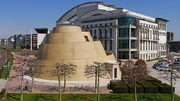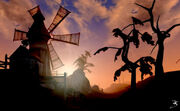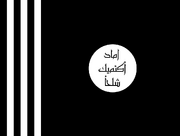Motto | |||||
| Anthem | "Glory to Barmenia" | ||||
| Capital | Juliania | ||||
| Largest city | Varistad | ||||
| Language | Brmek | ||||
| Religion main |
Ahmadism, Felinism | ||||
| others | Barmenian Apostolic Church | ||||
| Ethnic Group | Brmek, Kathuran | ||||
| Demonym | Barmenian | ||||
| Government | Theocratic monarchy | ||||
| Legislature | Madjlis | ||||
| Sultan | Jens I (Thaller Family) | ||||
| Forward-souled person and Speaker of the Sultan | Murad Imam | ||||
| Area | 856,800 km² | ||||
| Population | 99,620,894 | ||||
| GDP Total: |
2,496,562,386,324 BAR | ||||
| per capita | 25,060 BAR | ||||
| Currency | Barmenistan (BAR) | ||||
| Drives on the | Right | ||||
| Internet TLD | .bar | ||||
Barmenistan (Brmek: برمستات Brmestán), officially the Thallerid Ahmadi Sultanate of Barmenistan (Brmek: یرلیی امادصرلی سلتنکنستات برمستات Jrlijé Ám'ádsrlji Sltnknstat Brmestán) is a nation situated on the continent of Majatra. It is bordered by the Verranderlijke Ocean to the west, Beiteynu to the north-west, Pontesi to the north-east, the Majatran Sea to the east, and Vanuku to the south.
History
Overview of Barmenia
| Year | Flag | Name | Government Type |
| c. 350 BCE - 13 CE | Cildanian Hegemony | Province of oligarchic republic | |
| 13 CE - 921 CE | Jelbic and Qedarite tribes | Tribal polities | |
| 921 - 1154 | Sacred Monarchy of Beiteynu | Theocratic monarchy | |
| 1154 - 1435 | Kingdom of Arakhim | Monarchy | |
| 1186 - 1486 | Ahmadi Empire | Theocratic monarchy | |
| 1486 - 2142 | Bunjamínid Caliphate | Theocratic monarchy | |
| 2142 - 2287 | Democratic Republic of Barmenistan | Democratic republic | |
| 2287 - 2338 | Traviscist Dictatorship of Barmenistan | Military dictatorship | |
| 2338 - 2806 | Democratic Government of the Barmenians | Democratic republic | |
| 2806 - 2872 | Barmenian Commonwealth | Caliphate & Shahdom | |
| 2872 - 2951 | Vanukean occupation | Occupied territory of Vanuku | |
| 2951 - 3134 | Grand State of Barmenia | Selucian monarchy | |
| 3134- 3389 | Feline Homeland of Barmenia | Felinist theocracy | |
| 3389 - 3435 | Sacred Lacerik Empire of Barmenia | Theocratic monarchy | |
| 3435 - 3497 | Barmenistan Caliphate | Theocratic monarchy | |
| 3497 - 3542 | Felinist Republic of Barmenia | Theocratic republic, constitutional monarchy | |
| 3542- 3561 | People's Republic of Barmenia | Socialist republic | |
| 3561-3638 | Felinist Republic of Barmenia | Theocratic republic, constitutional monarchy | |
| 3638-3645 | Khanate of Barmenia | Temrkaid vassal | |
| 3645-3677 | Felinist Republic of Barmenia | Theocratic republic, constitutional monarchy | |
| 3677 - 3738 | Republic of Barmenia | Republic | |
| 3738 - 3788 | Felinist Republic of Barmenia | Theocratic republic, constitutional monarchy | |
| 3788 - 3811 | Shahdom of Barmenia | Absolute monarchy & part of Khaganate | |
| 3811 - 3820 | Genzid Caliphate | Theocratic monarchy | |
| 3820 - 3862 | Democratic Republic of Barmenistan | Kathuran apartheid republic | |
| 3862 - 3869 | Ahmadi Republic of Barmenistan | Confessional republic | |
| 3869 - 3878 | Republic of Barmenia | Kathuran apartheid republic | |
| 3878-4015 | Kingdom of Barmenia | Hosian, Kathuran centered Monarchy | |
| 4015 - 4016 | People's Republic of Barmenia | Socialist republic, military dictatorship | |
| 4016 - 4160 | Kingdom of Barmenia | Hosian, Kathuran centered Monarchy | |
| 4160 - 4180 | Qedarite Kingdom of Barmenia | Secular nationalist dictatorship, monarchy | |
| 4180 - 4204 | Kingdom of Barmenia | Hosian, Kathuran centered Monarchy | |
| 4204 - 4220 | Eternal Sultanate of Barmenistan | Constitutional monarchy | |
| 4220 - 4266 | Kingdom of Barmenia | Hosian, Kathuran centered Monarchy | |
| 4266 - present | Thallerid Ahmadi Sultanate of Barmenistan | Thallerid monarchy, Ahmadi and Felinist theocracy |
Culture

Ancient cat Ziggurat in Varistad, Murdhild
The culture of Barmenia has a wide mix of ethnic groups and cultures, with the Brmeks being the majority group. Barmenian culture began with the settlement of Qedarite tribes during the Qedarite Migrations. Little is known about the culture of prehistoric Qedarite society apart from a few stone tablets of Cuneiform script, statues and the few ziggurats they left behind. The Qedarites were gradually conquered by Jelbic-speaking tribes migrating from the south.

Mosque in Varistad
Barmenia is a nation of pristine lakes, stunning mountains and picturesque villages nestled in cosy grassy valleys. Barmenia's famous golden beaches have been zealously protected from over-development, making them amongst Terra's most precious beauty spots. The country's spectacular natural environment is a Mecca for mountaineers, hikers and nature lovers, not to mention enthusiasts of every variety of mountain and water activity, from canoeing to paragliding. A beehive in the backyard and a bee-keeping club meeting in the village pub are everyday sights in a land which makes oodles of the thickest-flowing gorgeously sweet oozing honey available anywhere in Terra. The national drink is mead, a luscious wine made with honey which is adored by locals and constitutes one of Barmenia's most successful exports.

Beautiful Barmenia
Barmenians love authentic handicrafts, homemade clothes and homemade food, shunning the mass manufactured products which have swamped other nations and wiped out once valued skills. Barmenians generally like to have an idea of who made the things we own and how they were made, prizing individuality and disdaining bland uniformity. Craftsmen, tailors, painters, musicians and other creative types swarm to Barmenia from all over Terra just to be in amongst the atmosphere and culture here. One of the greatest passions is oral storytelling, where village groups meet up within a friendly atmosphere in pubs, living rooms and public spaces to regale each other with tales, each speaker trying to be more entertaining than the previous one. Skill in this art is greatly esteemed, and many who began as storytellers have found themselves - often almost unwittingly! - propelled up the ranks of local or even national politics.
Though minorities of Selucian, Yeudi and Dunetrekkan descent exist, nearly all Barmenians are skilled in the language Brmék, a dialect of the Jelbic language family, largely mutually intelligible with other Jelbic languages such as Jelbék and Pnték.
Demographics
Religious groups
- Ahmadism 52%
- Hosianism 32%
- Barmenian Apostolic Church 21%
- Oseyim 5%
- Aurorian Patriarchal Church 4%
- Other 2%
- Felinism 6%
- Irreligious 5%
- Yeudism 3%
- Jelbic Shamanism 1%
- Other 1%
Ethnicity
- Brmékai 62%
- Kathuran 17%
- Majatrans 7%
- Selucian 3%
- Yeudi 3%
- Wrnukaek 3%
- Pntek 2%
- Other (Augustans, Luthorians, Solentians etc.) 3%
Government & Politics
The constitutional tradition of Barmenia was formerly based on the principle of subsidiarity, meaning that at least in theory, matters ought to be handled by the smallest, lowest, or least centralized authority capable of addressing that matter effectively. Many matters ranging from worker's rights, environmental protection, infrastructure and laws on morality were handled at the local level, by the Pashaluks, as the federal subjects were called in Barmenia.
Following the advent of the Republic and the rise of the Monarchy however, the Barmenian state underwent a long period of reform and centralization. The last of these acts, coinciding with the mid throes of the Barmenian Reformation, culminated in the creation of an elected nobility (replacing the old, aged system of appointed Governorship). By the death of King Amfn in 3937, most of the nation's decision making came from the Assembly and the monarch.
Barmenia was formerly governed under a system of confessionalism. However, following religious backlash and the rise of the Republic under militarist leader and President D'yaequob Eabaa, Ahmadi's lived under a system of mass incineration that was only relieved (conditionally) during the regency of King Eksandr. As a result, the nation became largely Hosian in its leaning. During this time, the system of 'nations' dissolved and gave way to a framework of policy incentives and punishments that was designed to root out pro-Ahmadi elements from the nation, and even gave a cold shoulder to certain Orthodox Yeudish temples.
The "Nation's" as they once existed:
| Nation | Religion | Ethnicity | Knsbék |
| Ahmadi Nation | Ahmadism | Brmeks, Majatrans | Caliph Abdlmecid Ám'ádíaék Shajh Bhtjar Mhmetsrmko Tuzmhamék |
| Kathuran Nation | Barmenian Apostolic Church | Kathurans, Brmeks, Pnteks, Arev Mardik | Patriarch of Kathura Rabona bar Maʿdani |
| Selucian Nation | Selucian Patriarchal Church | Selucians | Primate of Barmenia Athanasius IV |
| Osean Nation | Oseyim | Yeudis, Brmeks | Patriarch of Dinah Abraham ben Elior |
| Yeudi Nation | Yeudism | Yeudis | Chief Rebbe of Barmenia Eliezer Dror |
| Augustan Nation | Terran Patriarchal Church | Augustans, Wrnukek | Ambassador of Zardugal Kaliniko Eŭtiĥiano |
The Monarchy
Barmenia is governed under an executive constitutional monarchy with Hosian preference (though the constiution does allow for Halawite rulers, which all Ahmadi's claimed to be, post incarceration).
The monarch of Barmenia also holds the title of King of Arakhim and claims the title of King of Cildania and Hebile. The monarchy's claim to the latter two title's has been disputed by the governments of Vanuku and Cildania, due to dynastic and military pursuits.
In the past Barmenia was ruled by Shahs and Caliphs. During the Felinist era, Barmenia was governed by the House Mede, which hails from the Selucio-Barmenians, though most of it's members are not of purely Selucian descent nowadays. The traditional throne room in Varistad as well as the institution itself was refereed to as the Sun-Cured Throne. Under the Medes, the Shah/Shahbanu was not an ordinary constitutional monarch, but Jezmrjkai (Brmék: Great Protector) of the Felinist Republic. This being a result of Barmenia's historical conflict with several monarchic powers usually afflicted with the Caliphate and Ahmadism, as opposed to Felinist Republicanism.
Administrative divisions
Barmenia is divided into six provinces, each governed by a Duke or Duchess named by the Head of State, voted on by the Assembly and retained via a vote of the people.
| Pashaluk | Flag | Population | Area | Capital |
| Murdhild | 
|
19,973,606 | 267,900 km² | Varistad |
| Ikegaru | 
|
19,911,381 | 175,500 km² | Temrkaistad |
| Sisula | 
|
19,909,044 | 108,300 km² | Sísle Jezstad |
| Uthena | 
|
19,970,366 | 160,200 km² | Séleuefluz |
| Arakhim | 
|
8,486,164 | 73,600 km² | Korat |
| Kathuristan | 
|
11,365,891 | 71,300 km² | Kathura |
Military

War flag of the Caliphate
The military of Barmenia had for a long time been built around the idea of an autonomous and decentralized warrior caste. The government had only directly operated a small part of the Empire's military, and mostly subcontracted semi-military control to private intrapreneurs, bringing a system of competition to the Barmenian millitary which is believed to have led to great improvements to its quality, combined with the compulsory conscription of all young Barmenian men and women. There were also many paramilitaries belonging to one of the political parties, or acting independently or working on a regional basis. One of the more famous paramilitaries is the Legion of the Fourth Sword, who shot down a Pontesi airplane violating Barmenian aerospace.


